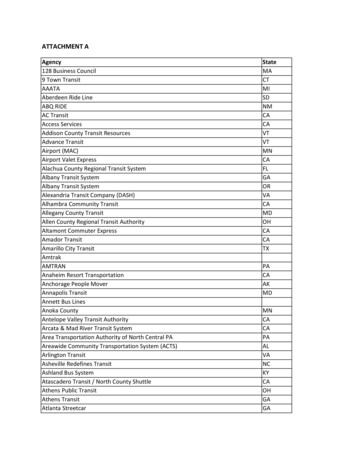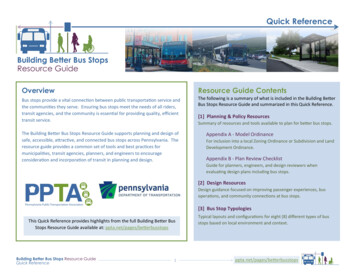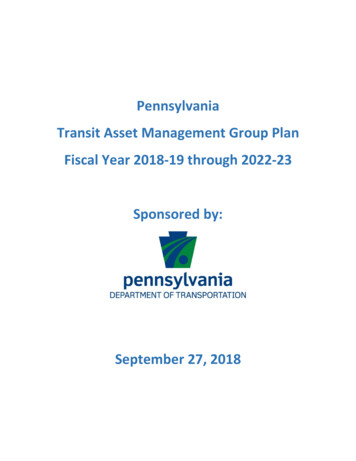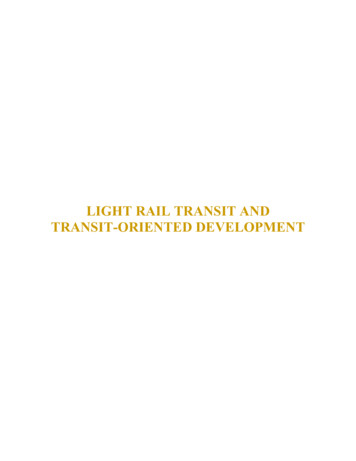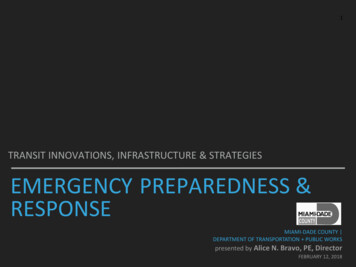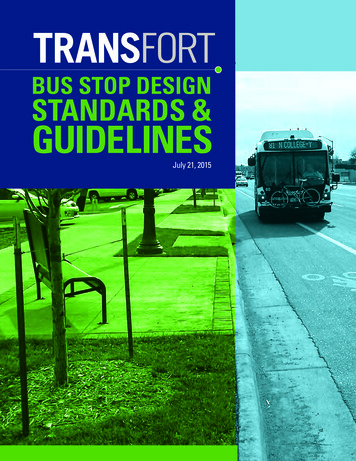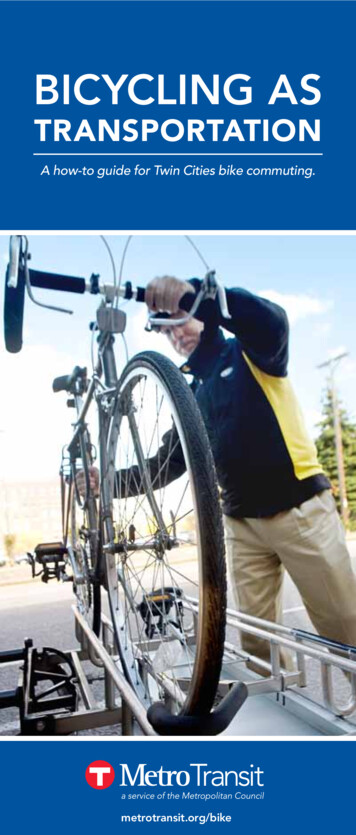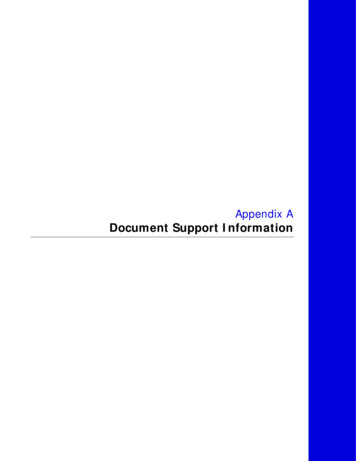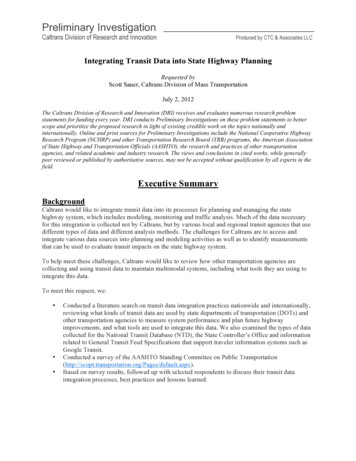
Transcription
Preliminary InvestigationCaltrans Division of Research and InnovationProduced by CTC & Associates LLCIntegrating Transit Data into State Highway PlanningRequested byScott Sauer, Caltrans Division of Mass TransportationJuly 2, 2012The Caltrans Division of Research and Innovation (DRI) receives and evaluates numerous research problemstatements for funding every year. DRI conducts Preliminary Investigations on these problem statements to betterscope and prioritize the proposed research in light of existing credible work on the topics nationally andinternationally. Online and print sources for Preliminary Investigations include the National Cooperative HighwayResearch Program (NCHRP) and other Transportation Research Board (TRB) programs, the American Associationof State Highway and Transportation Officials (AASHTO), the research and practices of other transportationagencies, and related academic and industry research. The views and conclusions in cited works, while generallypeer reviewed or published by authoritative sources, may not be accepted without qualification by all experts in thefield.Executive SummaryBackgroundCaltrans would like to integrate transit data into its processes for planning and managing the statehighway system, which includes modeling, monitoring and traffic analysis. Much of the data necessaryfor this integration is collected not by Caltrans, but by various local and regional transit agencies that usedifferent types of data and different analysis methods. The challenges for Caltrans are to access andintegrate various data sources into planning and modeling activities as well as to identify measurementsthat can be used to evaluate transit impacts on the state highway system.To help meet these challenges, Caltrans would like to review how other transportation agencies arecollecting and using transit data to maintain multimodal systems, including what tools they are using tointegrate this data.To meet this request, we: Conducted a literature search on transit data integration practices nationwide and internationally,reviewing what kinds of transit data are used by state departments of transportation (DOTs) andother transportation agencies to measure system performance and plan future highwayimprovements, and what tools are used to integrate this data. We also examined the types of datacollected for the National Transit Database (NTD), the State Controller’s Office and informationrelated to General Transit Feed Specifications that support traveler information systems such asGoogle Transit.Conducted a survey of the AASHTO Standing Committee on Public es/default.aspx).Based on survey results, followed up with selected respondents to discuss their transit dataintegration processes, best practices and lessons learned.
Summary of FindingsRelated Research and GuidanceWe gathered information in four topic areas: Data Sources.Software and Tools.Data Integration.California-Related Research.Following is a summary of findings by topic area.Data SourcesSeveral studies illustrate how data from Google’s General Transit Feed Specification (GTFS) can beintegrated into planning: A November 2011 study explored the use of the GTFS to assist transit agencies with serviceplanning and operations, and developed a web-based application that can display boardings andalightings along transit routes, which can provide useful information for enhancing transitservices to meet ridership demands. A May 2011 study used GTFS along with walking and biking data from OpenStreetMap todevelop a multimodal trip planning tool.Software and Tools Florida DOT has developed a web-based system that integrates more than 20 years of NTD dataand provides user-friendly tools designed to facilitate the access and analysis of transitperformance data. This tool is part of the Florida Transit Information System (FTIS).Data Integration A recent TRB Annual Meeting workshop reviewed the state of the practice in urban dataintegration and next steps in relevant research and practice including ongoing efforts on state,regional and local levels; public- and private-sector roles; and academic research with large-scaledata integration system development and deployment.A 2009 report describes a plan for collecting and analyzing transit data to evaluate the impacts oftransit projects on highway congestion, and a 2008 report includes guidance on incorporatingtransit and other multimodal strategies into developments of regional impact reviews (DRIs)conducted by Florida DOT staff to evaluate impacts on the state transportation system.California-Related Research A 2007 report examines the state of the practice in California transit agencies for the use andsharing of data for operations monitoring, service planning, performance measurement andcustomer information. (See Assessment of Information Systems and Technologies at CaliforniaTransit Agencies in California-Related Research.)2
Survey and Interview ResultsOur survey to members of the AASHTO Standing Committee on Public Transportation consisted of thefollowing questions:1. Does your agency integrate transit data from local and regional agencies into systems andprocesses for planning and managing the performance of the state highway system and themultimodal transportation system as a whole (including modeling, monitoring and trafficanalysis)?If yes to 1:2. What kinds of transit data and transit-related performance measures (e.g., routing, scheduling andridership) do you use? What are the sources of this transit data?3. What software, processes and other tools do you use to integrate transit data into your planningsystems? How are they integrated?4. How do you use the integrated data? What functions and decision-making processes aresupported?Staff at 15 state DOTs responded to this survey (see Survey and Interview Results beginning on page 12of this report for the full text of these survey responses), and we obtained results for Indiana and Oregonby phone. We also attempted to contact representatives from Arizona, New Jersey, New York andVirginia DOTs by phone but were unable to reach them.Of 17 respondents, four said they integrated transit data into state highway planning: Florida, Nevada,Ohio and Rhode Island. We conducted follow-up interviews with Florida and Ohio, but were unable toreach Rhode Island and Nevada. Key findings include: When it comes to integrating data, both Florida and Ohio have an engineer or contractor manuallycode transit agency information into a travel demand model. Both use the software applicationCube for travel demand modeling. Florida uses ridership (passenger trips), passenger miles, vehicle miles, revenue miles andrevenue hours to help to determine how well it meets statewide transportation plan and agencygoals. Data sources include the NTD and local agency route, stop data, GTFS or GIS headways,automatic passenger count (APC), survey and scheduling data for transit modeling. Florida usesits custom FTIS to pull peer information and the NTD performance measure data. (For moreinformation, see “System for Transit Performance Analysis Using the National Transit Database”in Data Sources and the Florida Transit Information System in Software and Tools.) Thesemodels are used to determine the best use of state resources guide policies, strategies and goals. Minnesota requests data from transit agencies individually for incorporation into a Twin Citiesregional model (but does not include transit in its statewide model). It uses routing and ridershipdata to scope projects and traffic management plans for construction. Missouri does not use transit data to manage its state highway system, but collects and reports ontransit data and uses it for managing grant programs. Nevada incorporates transit into modeling for urban areas. New Hampshire is integrating transit data into its performance management system, and will useridership and fleet age as performance measures. Data sources will include the NTD andinventory data for state-owned buses. Ohio uses routing, scheduling, ridership, and park and rides for performance measures, and usesdata from regional transit agencies (RTAs) or service providers. These models are used forplanning transit-related projects.3
Rhode Island uses bus transit ridership data in its statewide model and uses TransCAD TDMsoftware to run this model, which is used for multimodal system planning.Gaps in Findings There seems to be a dearth of literature directly discussing the challenges of integrating transitdata into planning for a state highway system as a whole. Most studies are focused specifically ontransit forecasting without a view to broader impacts.Few states surveyed incorporate transit data into their state highway planning, and several stateswith large transit systems did not respond to the survey. We followed up with such states,including New York, by email and phone, but did not receive a response.We were unable to reach Nevada and Rhode Island—two of the few survey states to incorporatetransit data into state highway planning—for follow-up interviews.Next StepsMoving forward, we recommend that Caltrans: Follow up with respondents from Nevada and Rhode Island about their transit data integrationpractices.Contact states with large transit systems that we were unable to reach within the scope of thisPreliminary Investigation.Contact Karl Petty of Berkeley Transportation Systems concerning his work on urban dataintegration. (Dr. Petty gave a presentation on this subject at the recent TRB Annual Meeting. SeeIntegrating Arterial, Transit, and Freeway Data for the Urban Environment in Data Integration.)Explore FTIS, which integrates more than 20 years of NTD data.4
ContactsDuring the course of this Preliminary Investigation, we spoke to or corresponded with the followingindividuals:FloridaDiane QuigleyTransit Planning AdministratorFlorida Department of Transportation(850) 414-4520, diane.quigley@dot.state.fl.usIndianaRoy NunnallyDirector, Long Range Planning, Modeling and Traffic Counting DivisionIndiana Department of Transportation(317) 234-1692, rnunnally@indot.state.in.usOhioRebekah Straub AndersonOffice of Statewide Planning and ResearchOhio Department of Transportation(614) 752-5735, rebekah.anderson@dot.state.oh.usOregonDinah Van Der HydeTransit Operations ManagerOregon Department of Transportation(503) 986-3885, dinah.vanderhyde@odot.state.or.us5
Related Research and GuidanceData SourcesGeneral Transit FeedGeneral Transit Feed, Google Developers, om the web site: The General Transit Feed Specification (GTFS) defines a common format for publictransportation schedules and associated geographic information. GTFS feeds allow public transit agenciesto publish their transit data and developers to write applications that consume that data in an interoperableway. GTFS can be used to power trip planners, timetable publishers, and a variety of applications, toodiverse to list here, that use public transit information in some way.Related Resources:Example GTFS Feed, Google Developers, amples/gtfs-feedGTFS feeds consist of comma-delimited text files for such data as stops, routes, trips and otherschedule data. An example of a GTFS feed is shown on this web page.General Transit Feed Specification Reference, Google Developers, ferenceThis guide provides more information about the types of files in a GTFS transit feed and defines thefields used in those files.GoogleTransitDataFeed, Google Project Hosting, feed/wiki/PublicFeedsA listing of publically available transit feeds is provided.“How Google and Portland’s TriMet Set the Standard for Open Transit Data,” SFStreetsBlog.org,January 5, transitdata/This article describes the origins of the GTFS (formerly the Google Transit Feed Specification) andGoogle’s cooperation with Portland’s TriMet public transportation agency to develop the specification.“Welcome to Google Transit: How (and Why) the Search Giant is Remapping PublicTransportation,” Community Transportation, 2012: articlefiles/Spring 12 DigitalCT Google Transit.pdfThis article includes examples of ways in which the GTFS has been used to create applications for SanFrancisco’s Bay Area Rapid Transit (BART) system and for Portland’s transit agency, TriMet.6
Expanding the Google Transit Feed Specification to Support Operations and Planning, NationalCenter for Transit Research, November 2011.Final Report: d Proj/Summary PTO/FDOT BDK85 977-15 rpt.pdfSummary: d Proj/Summary PTO/FDOT BDK85 977-15 sum.pdfThis project investigated using the GTFS to further assist transit agencies with business activities, such asservice planning and operations. Researchers first conducted interviews in transit agencies to see howGTFS data was being used. They then created and deployed a prototype application that integrated GTFSdata with APC data. This web-based application can be used by transit agencies to display boardings andalightings along transit routes during specific times of day. Researchers deployed the prototype on a testweb site using transit data for selected routes in San Diego (http://ridership.transitgis.org/). Users wereable to choose a route and see its map and its stops. They were also able to select from a variety of graphsand tabulations displaying ridership statistics and characteristics aggregated in different ways, forexample, by route, stop or trip. For the majority of transit systems, which do not have highly integratedinformation systems or substantial IT resources, the prototype application can provide useful informationfor decision makers in adjusting and enhancing transit services to meet ridership demands.Enabling Cost-Effective Multimodal Trip Planners Through Open Transit Data, National Center forTransit Research, May 2011.Final Report: d Proj/Summary PTO/FDOT BDK85 977-20 rpt.pdfSummary: d Proj/Summary PTO/FDOT BDK85 977-20-sum.pdfThis study examined whether a multimodal trip planner can be developed using open‐source software andopen data sources, including OpenStreetMap (OSM) and Google’s GTFS (used by more than 125 publictransportation agencies in the United States). The research team evaluated the use of OpenTripPlanner, anopen-sourced multimodal trip planning software system, for routing in Tampa, FL, using OSM biking andwalking data and GTFS transit data. The study team also recorded multimodal data for the Tampa regionin OSM to examine the current OSM coding conventions and determine the coding system’s ability tosupport functions required of a multimodal trip planner, such as providing information about access totransit, wheelchair accessibility or conditions that could affect the safety of a trip (e.g., intersectioncrossings).The research team created GTFS‐OSM‐Sync (GO Sync), a framework and open‐source software tool forsynchronizing transit data between the transit agency’s official GTFS dataset and OSM. GO Syncconnects the wealth of data from GTFS datasets to the ability of the OSM community to augment andimprove the data. During a test deployment of GO Sync in Tampa, OSM users corrected 173 bus stoplocations. The project demonstrated that it is feasible to implement a multimodal trip planner usingopen‐source software and open data sources.Evaluation of Software Solutions for Transit Scheduling and Data Integration, University of Texasat Austin, November 2002.http://www.utexas.edu/research/ctr/pdf reports/1884 2.pdfFrom the report: The primary goals of this project are to investigate the technical problems associatedwith integrating data from several external agencies, and to recommend (1) an existing commerciallyavailable dispatching and scheduling system that can be used by all Texas paratransit systems and(2) implement improvements for the transit agencies and their external partners that will enable them torealize the full benefits of the new system.7
National Transit DatabaseNational Transit Databasehttp://www.ntdprogram.gov/ntdprogram/The NTD was established by Congress to serve as the nation’s primary source for information andstatistics about U.S. transit systems. It collects annual transit performance and financial data, monthlyridership data, and safety and security data that are summarized in annual reports.“System for Transit Performance Analysis Using the National Transit Database,” Journal of PublicTransportation, Vol. 14, No. 3, 2011: 2011/10/JPT14.3Gan.pdfFrom the article: This paper introduces a web-based system that integrates over 20 years of NTD dataand provides user-friendly tools designed to facilitate the access and analysis of transit performancedata. The system is useful for both practitioners and researchers who use the NTD data to improvetransit performance and services.Software and ToolsThe Integrated National Transit Database Analysis System, Florida Department of Transportation.http://www.ftis.org/intdas.htmlFrom the web site: Each year, more than 600 of the nation’s transit agencies report data to the FederalTransit Administration (FTA) for inclusion in the National Transit Database (NTD) which includesdata on transit organization characteristics, vehicle fleet size and characteristics, revenues and subsidies,operating and maintenance costs, safety and security, vehicle fleet reliability and inventory, and servicesconsumed and supplied. These data have been used extensively to derive values for transit performancemeasures and have become the sole source of standardized and comprehensive data for use by allconstituencies of the transit industry. The current version of [the Integrated National Transit Database Analysis System (INTDAS)]integrates the 1984-2010 NTD data for all transit systems reported to the NTD program and providescustomized tools for easy data retrieval, visualization, analysis, and transfer.Note: INTDAS is a component of FTIS.Florida Transit Information System, Florida Department of Transportation, 2011.http://www.ftis.org/index.htmlFrom the web site: The Florida Transit Information System (FTIS) is a user-friendly software systemdesigned specifically for transit planning applications. The current version of FTIS includes the followingthree major system components: Integrated National Transit Database Analysis System (INTDAS): A web database systemdesigned for the retrieval and analysis of the 1984-2010 National Transit Database (NTD). Florida Transit Geographic Information System (FTGIS): A stand-alone web GIS systemcustomized for the planning of Florida’s transit systems. Automated Transit Stop Inventory Model (ATSIM): A hybrid mobile-desktop system for thecollection, analysis, and maintenance of transit stop inventories.FTIS has become a major software tool for the transit industry, with many users from across the country.TransCAD, Caliper Corporation, I4irVYurkTransCAD is travel demand software commonly used by transportation agencies (including Caltrans:http://www.dot.ca.gov/hq/tsip/microsim/). It includes GIS-based representations of transit systems, and8
can place transit routes directly on streets so that interactions between autos and transit can be treatedexplicitly.Arterial Performance Measurement in the Transportation Performance Measurement System(PeMS), Berkeley Transportation Systems, Inc., May 2011.http://www.mtc.ca.gov/services/arterial operations/downloads/pems arterials 2011 05 10 v3.pdfThis presentation describes the Arterial Performance Measurement in the Transportation PerformanceMeasurement System (PeMS), which includes transit data tools such as passenger count and automaticvehicle location (AVL) integration, on-time performance, loading analysis and travel times.Related Resources:The Promise of PeMS (Performance Monitoring System), National Transportation OperationsCoalition, October 2002.http://www.ntoctalks.com/icdn/pems wolf.phpFrom the web site: After several years of development and evaluation by early users, PeMS(Performance Measurement System), developed by the University of California at Berkeley forCaltrans, is nearly “ready for prime time.” PeMS can potentially become a mainstream transportationsystem performance analysis tool for a wide variety of different users within Caltrans, includingdistrict managers, planners, and operations staff.Performance Measurement System (PeMS), Caltrans, 2012.http://pems.dot.ca.gov/PeMS integrates a wide variety of information from Caltrans and other local agency systems.Data IntegrationIntegrated Corridor Management, Intelligent Transportation Systems Joint Program Office, U.S.Department of Transportation Research and Innovative Technology Administration, undated.http://www.its.dot.gov/icms/icm awarded.htmFrom the web site: The primary objective of the Integrated Corridor Management (ICM) Initiative is todemonstrate how innovative transportation strategies and Intelligent Transportation Systems (ITS)technologies can efficiently and proactively facilitate the movement of people and goods through majormetropolitan transportation corridors using the integrated, dynamic management of freeway, arterial,transit, and parking systems within a corridor with ITS technologies and innovative practices or strategies.Integrating Arterial, Transit, and Freeway Data for the Urban Environment, TransportationResearch Board 91st Annual Meeting, program/PresentationDetails.aspx?ID 51301http://amonline.trb.org/2137jc/2From the web site: With the explosion of numerous new transportation data sources and data collectiontechnologies, data integration issues are of crucial importance. This workshop reviews the state of thepractice in urban data integration and next steps in relevant research and practice including ongoingefforts on state, regional, and local levels; public- and private-sector roles; and academic research withlarge-scale data integration system development and deployments.Minnesota Urban Partnership Agreement—National Evaluation: Transit System Data Test Plan,U.S. Department of Transportation, situpa.pdfFrom the abstract: This report presents the test plan for collecting and analyzing transit system data forthe Minnesota Urban Partnership Agreement (UPA) National Evaluation under the United StatesDepartment of Transportation (U.S. DOT) UPA Program. The Minnesota UPA projects focus on reducing9
congestion by employing strategies consisting of combinations of tolling, transit, telecommuting/TDM,and technology, also known as the 4 Ts. This test plan is based on the Minnesota UPA NationalEvaluation Plan. It presents the sources for obtaining the data needed to evaluate the impacts of theMinnesota UPA transit projects, the data availability, and the risks associated with collecting andanalyzing the data. The data analysis techniques are described and the schedule and responsibilities arepresented.Integrated Corridor Management: Analysis, Modeling and Simulation (AMS) Methodology,Cambridge Systematics, Inc., March 2008.http://ntl.bts.gov/lib/jpodocs/repts te/14414 files/14414.pdfFrom the abstract: This AMS Methodologies Document provides a discussion of potential ICManalytical approaches for the assessment of generic corridor operations. The AMS framework describedin this report identifies strategies and procedures for tailoring AMS general approaches toward individualcorridors with different application requirements and modeling characteristics.Guidelines and Performance Measures to Incorporate Transit and Other MultimodalConsiderations into the FDOT DRI Review Process, National Center for Transit Research, is report includes guidance on incorporating transit and other multimodal strategies into developmentsof regional impact (DRIs) reviews conducted by Florida DOT staff to evaluate impacts on the statetransportation system. Other transportation planning partners such as regional planning councils,metropolitan planning organizations (MPOs), local governments, transit authorities and agencies,transportation management associations and the development community may find these guidelinesuseful in the development review process.Review of and Preliminary Guidelines for Integrating Transit into Transportation ManagementCenters, Federal Highway Administration, July 1994.http://ntl.bts.gov/lib/jpodocs/repts te/2826.pdfThis study reviews transportation management centers to assess their integration of transit, including theimpacts of public transportation on traffic flow.Related Resource:“Information Requirements for an Integrated Transit/Traffic Management and TravelerInformation System,” IVHS Journal, Vol. 1, Issue 2, 1993: /10248079308903790From the abstract: This paper documents the assessment of the information requirements for thedevelopment of an Integrated Transit/Traffic Management and Traveler Information System. Theidentification of information requirements represents one of several phases of the informationgathering process which was necessary to evaluate the suitability of available technologies, IVHSelements, and architectures for the design of an operational test of the integration of transit and trafficmanagement and traveler information system. The integration design includes the automated transferof operations and management information between agencies and to the public in order to realizeefficiencies in the transportation network. The paper details the information requirements of threepublic agencies involved in transportation management together with transportation informationrequirements of the traveling public. Availability of the required data is assessed and existing andpotential data sources are identified.10
California-Related ResearchStream Traffic Data Archival, Querying, and Analysis with TransDec, University of SouthernCalifornia, Los Angeles, January 2011.http://www.metrans.org/research/final/10-13 Shahabi final.pdfFrom the abstract: The goal of this research was to extend the traffic data analysis of the [TransportationDecision-Making (TransDec)] system, which is a real-data driven system to support decision-makingin transportation systems. [We performed] three tasks. First, we developed new techniques to create astreaming data archival repository that supports continuous querying and analysis of the vast amount ofCalifornia transit data from RIITS (Regional Integration of Intelligent Transportation Systems) generatedin the form of data streams. Second, we extended the current data-tier of TransDec to a distributed designto enable more scalable and stable computing environment. Finally, to demonstrate the benefits of thearchived traffic datasets, we presented a novel proof-of-concept application, namely time-dependentoptimal sequenced route (TD-OSR) planner using congestion prediction. This application exploits asubset of the real-world RIITS datasets, and [we are] evaluating the ways to make it available for publicuse.Public Transit in California: Existing Conditions and Current Practices, University of CaliforniaTransportation Center, it in CA slides finaldraft.pdfSlide 17 provides common performance measures used by California transit agencies.San Diego I-15 Integrated Corridor Management (ICM) System: Stage II (Analysis, Modeling, andSimulation), California PATH Program , Institute of Transportation Studies, University of California,Berkeley, March s/PDF/PRR/2010/PRR-2010-09.pdfThis report provides background about efforts to date of the U.S. DOT ICM system program for theInterstate 15 corridor in San Diego County, CA, one of eight sites selected to participate in the U.S. DOTICM program. The program’s goal is to counteract the effects of increasing congestion area on freeways,arterials and the public transit network. The report describes the decision support system that willeventually be able to generate suggested action plans in response to regional events such as dailyrecurring peak hour traffic, planned football games or unexpected situations such as firestorms thatdisrupt traffic.Study of Integrated Corridor Management for San Francisco Bay Area I-880 Area Corridor,California PATH Program, Institute of Transportation Studies, University of California, Berkeley,November s/PDF/PRR/2008/PRR-2008-30.pdfThe I-880 corridor in the San Francisco Bay Area is a multimodal corridor that includes a robust freewaynetwork, major arterials carrying high volumes of local traffic, a rail and bus transit network, and heavyfreight traffic. This report summarizes the findings of three studies dealing with the I-880 ICM program.The three studies focused on the concept of operation; sample data for analysis, modeling and simulation;and system requirements.“Assessment of Information Systems and Technologies at California Transit Agencies,”Transportation Research Record, January 18, 2007 3850262h/This report examines the current state of the practice in California transit agencies for the use and sharingof data for operations monitoring, service planning, performance measurement
Much of the data necessary for this integration is collected not by Caltrans, but by various local and regional transit agencies that use different types of data and different analysis methods. The challenges for Caltrans are to access and integrate various data sources into planning and modeling activities as well as to identify measurements
